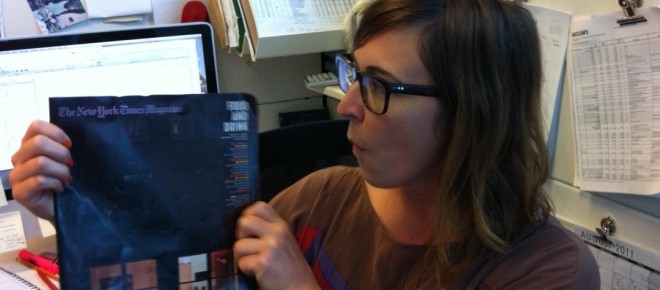The NYT’s annual food and drink issue is here!
Is there a better way to find out why sandwiches taste better when other people make them?
Share
 Sometimes I flinch when I shell out $8.40 for a copy of the Sunday New York Times. But not yesterday! Inside was the fourth annual food and drink issue and it was chock full of “mysteries, riddles and impertinent questions” answered by some of the Times’ most beloved contributors, including Mark Bittman, Sam Sifton, Amander Hesser and Eric Asimov. Despite having so much to do yesterday, I ended up reading the entire thing cover to cover. It took me all morning. Several cups of coffee were consumed. And even though I forget most of the really good ideas that were born as a result of my labours, I have no regrets. (Just a bit of gut rot.)
Sometimes I flinch when I shell out $8.40 for a copy of the Sunday New York Times. But not yesterday! Inside was the fourth annual food and drink issue and it was chock full of “mysteries, riddles and impertinent questions” answered by some of the Times’ most beloved contributors, including Mark Bittman, Sam Sifton, Amander Hesser and Eric Asimov. Despite having so much to do yesterday, I ended up reading the entire thing cover to cover. It took me all morning. Several cups of coffee were consumed. And even though I forget most of the really good ideas that were born as a result of my labours, I have no regrets. (Just a bit of gut rot.)
There are some really great spreads, like Mark Bittman’s Dinner Party Matrix—a guide that promises to deliver stress-free dinner parties. I don’t believe in stress-free dinner parties, but I’m still going to try making several of the 48 recipes, like any one of the four fennel salads and the roasted pork with cilantro puree. And I love, love, love that every one of the recipes—which are all classic Bittman—are 50 words or less. Paul Wells is just as excited.
Foodie hero Michael Pollan answers a whole whack of reader’s questions. Some of his answers may not be that revelatory, like the fact that generic brands are often the exact same as labeled ones or that frozen vegetables are just as nutritious as fresh. But I suspect you’ll read on, if only to glean more about the author of the Omnivore’s Dilemma. For example, the only foods he won’t eat are feedlot meats and refrigerated tomatoes (I’m guilty of consuming the former but never the latter.) And when asked what he thinks of gluten-free diets, Pollen doesn’t discount how important they are for sufferers of celiac disease or for those that can’t tolerate gluten. But he also posits how strange it is that bread, “a staple of Western civilization for 6,000 years, is suddenly making millions of us sick? I’m dubious.” So am I.
Sam Sifton writes a great piece, that’s accompanied by some lovely photographs, on why eating together as a family is important. I presume that everybody knows this, but still, some of the stats he cites are staggering: children have stronger vocabuluaries, do better in school, are less likely to get fat—and pregnant—when they eat regularly around the table. And even though Sifton rarely eats with his family on account of him being the restaurant critic for the Times, he makes sure that when he does, it’s a celebratory affair with neighbours and friends included in on the feasting.
But my favourite parts are all the little tidbits of information and factoids that come courtesy of a team of food pundits that permeate the entire issue. What’s the best single way to make coffee? Should I be afraid of low calorie sugar-substitutes? Why do sandwiches taste better when someone else makes them? You might disagree with the bits on what are the best novel, cook book, movie and art having to do with food (I did), but at the very least, it’s great food for thought. Oh, and don’t miss Bill Buford’s account of the most delicious thing he’s ever eaten (warning: it’s not for the faint of heart).
I’ve said too much. Just go and buy it. It’s an issue you’ll want to hang onto for a long time.